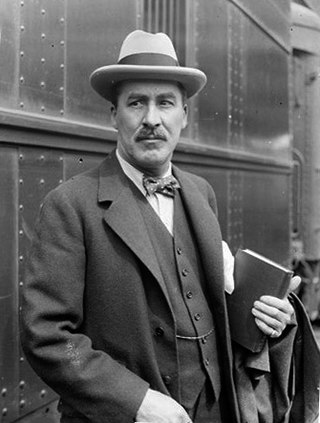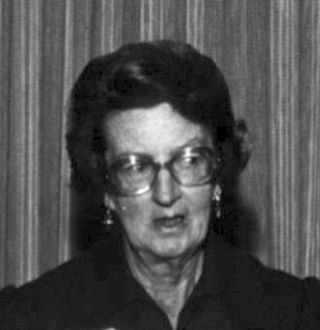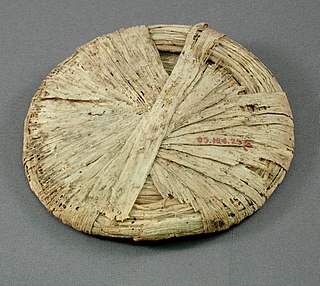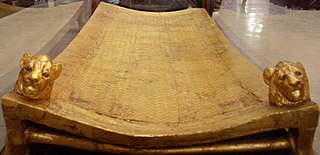Related Research Articles

Howard Carter was a British archaeologist and Egyptologist who discovered the intact tomb of the 18th Dynasty Pharaoh Tutankhamun in November 1922, the best-preserved pharaonic tomb ever found in the Valley of the Kings.

Mary Douglas Leakey, FBA was a British paleoanthropologist who discovered the first fossilised Proconsul skull, an extinct ape which is now believed to be ancestral to humans. She also discovered the robust Zinjanthropus skull at Olduvai Gorge in Tanzania, eastern Africa. For much of her career she worked with her husband, Louis Leakey, at Olduvai Gorge, where they uncovered fossils of ancient hominines and the earliest hominins, as well as the stone tools produced by the latter group. Mary Leakey developed a system for classifying the stone tools found at Olduvai. She discovered the Laetoli footprints, and at the Laetoli site she discovered hominin fossils that were more than 3.75 million years old.

Tomb KV43 is the burial place of Thutmose IV, a pharaoh of the Eighteenth Dynasty in the Valley of the Kings in Luxor, Egypt. He was interred with two of his children who predeceased him. The tomb has a dog-leg shape, typical of the layout of early Eighteenth dynasty tombs. KV43 was rediscovered in 1903 by Howard Carter, excavating on behalf of Theodore M. Davis.

KV20 is a tomb in the Valley of the Kings (Egypt). It was probably the first royal tomb to be constructed in the valley. KV20 was the original burial place of Thutmose I and later was adapted by his daughter Hatshepsut to accommodate her and her father. The tomb was known to Napoleon Bonaparte's expedition in 1799 and had been visited by several explorers between 1799 and 1903. A full clearance of the tomb was undertaken by Howard Carter in 1903–1904. KV20 is distinguishable from other tombs in the valley, both in its general layout and because of the atypical clockwise curvature of its corridors.
The year 1972 in archaeology involved some significant events.
Below are notable events in archaeology that occurred in 1902.
Below are notable events in archaeology that occurred in 1907.

Tomb KV54 is located in the Valley of the Kings, in Egypt. It was originally excavated by Edward R. Ayrton on behalf of the American lawyer Theodore M. Davis, who funded the work.
Herbert Eustis Winlock was an American Egyptologist and archaeologist, employed by the Metropolitan Museum of Art for his entire career. Between 1906 and 1931 he took part in excavations at El-Lisht, Kharga Oasis and around Luxor, before serving as director of the Metropolitan Museum from 1932 to 1939.

Theodore M. Davis was an American lawyer and businessman. He is best known for his excavations in Egypt's Valley of the Kings between 1902 and 1913.

Harry Burton was an English archaeological photographer, best known for his photographs of excavations in Egypt's Valley of the Kings. Today, he is sometimes referred to as an Egyptologist, since he worked for the Egyptian Expedition of the Metropolitan Museum of Art for around 25 years, from 1915 until his death. His most famous photographs are the estimated 3,400 or more images that he took documenting Howard Carter's excavation of Tutankhamun's tomb from 1922 to 1932.
Carl Nicholas Reeves, FSA, is a British Egyptologist, archaeologist and museum curator.

Exhibitions of artifacts from the tomb of Tutankhamun have been held at museums in several countries, notably the United Kingdom, Soviet Union, United States, Canada, Japan, and France.

Menhet, Menwi and Merti, also spelled Manhata, Manuwai and Maruta, were three minor foreign-born wives of Pharaoh Thutmose III of the Eighteenth Dynasty. They are known for their lavishly furnished rock-cut tomb in Wady Gabbanat el-Qurud near Luxor, Egypt. They are suggested to be Syrian, as the names all fit into Canaanite name forms, although their ultimate origin is unknown. A West Semitic origin is likely, but both West Semitic and Hurrian derivations have been suggested for Menwi. Each of the wives bear the title of "king's wife", and were likely only minor members of the royal harem. It is not known if the women were related as the faces on the lids of their canopic jars are all different.

Arthur Cruttenden Mace was a Tasmanian-born English archaeologist and Egyptologist. He is best known for his work for the New York Metropolitan Museum, and as a part of Howard Carter's team during the excavation of Tutankhamun's tomb.
Myriam Seco Álvarez is a Spanish archaeologist and Egyptologist. A distinguished authority in those fields, the author of several reference books, and responsible for excavations in the Middle East and Egypt, she has launched and directed important archaeological projects, including the excavation and restoration of the mortuary temple of Pharaoh Thutmose III. The so-called "Spanish Indiana Jones", she has had a prolific professional career and a broad international presence.
Emma Buttles Andrews (1837–1922) was a wealthy patron of archaeologists. As the companion of Theodore M. Davis, she accompanied him on excavations, documenting excavation finds and mapping tombs. Andrews served as honorary treasurer for the Newport branch of the Egypt Exploration Fund, in which Davis also served as a board member. The couple made a total of 17 trips along the Nile River aboard Davis's yacht the Bedawin, mainly to the Valley of the Kings in the hopes of uncovering new royal tombs. Her diaries from those trips give researchers rare glimpses into her work with Davis in Egypt.

Ernest Harold Jones was a British artist and excavator, who identified early clues to the location of Tutankhamun's tomb. He contracted tuberculosis and in 1904 he decided to go to Egypt to relieve his symptoms. He worked with archaeologist John Garstang, of Liverpool, from 1904–07 and then for Theodore M. Davis and Emma Andrews from 1907-11. He died of tuberculosis in Luxor, Egypt, in March 1911.

Arthur Robert Callender, nicknamed Pecky, was an English engineer and archaeologist, best known for his role as assistant to Howard Carter during the excavation of Tutankhamun's tomb in the 1920s.

Albert Morton Lythgoe was an American archaeologist and Egyptologist. He is best known for his work for the New York Metropolitan Museum of Art, and for the support he gave to the excavation of Tutankhamun's tomb, he releasing several key Metropolitan Museum staff to assist Howard Carter.
References
- ↑ "The scientific work". Archaeological Museum of Thebes . Retrieved November 23, 2017.
- ↑ "Gough's Cave excavation". Natural History Museum, London. Archived from the original on July 27, 2009. Retrieved August 22, 2007.
- ↑ Carter, Howard; Newberry, Percy E. (1904). The Tomb of Thoutmôsis IV. Westminster: Constable.
- ↑ "Works of Art Collection Database". Metropolitan Museum of Art. Retrieved June 27, 2011.
- ↑ "Louis Leakey". Britannica.com. Retrieved May 29, 2017.